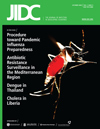Methicillin Resistant Staphylococcus aureus: Prevalence And Antibiogram In A Tertiary Care Hospital in Western Nepal
DOI:
https://doi.org/10.3855/jidc.86Keywords:
MRSA, western region, prevalence, NepalAbstract
Background: Methicillin resistant Staphylococcus aureus (MRSA) is a major cause of nosocomial and community infections. Its prevalence varies with country and with hospitals within a country. The current study estimates the prevalence of MRSA strains and investigates their antibiogram in western Nepal.
Methodology: A total of 162 S. aureus strains were isolated from various clinical specimens, and antibiotic susceptibility tests were performed using disc diffusion, growth on oxacillin screen agar, and oxacillin minimum inhibitory concentration (MIC).
Results: One hundred and twelve (69.1%) strains were found to be MRSA, of which 37 (33.1%) were community acquired and 75 (66.9%) were hospital acquired. Of 112 MRSA strains, 45 (40.1%) were multi-drug resistant. All MRSA strains were found resistant to penicillin, and 91.9%, 87.4%, 77%, and 55.5% were resistant to amoxicillin, ampicillin, trimethoprim/sulfamethoxazole, and cephalexin, respectively. However, low resistance was observed with amikacin (19%), ciprofloxacin (26.5%), and norfloxacin (30.6%). All strains were sensitive to vancomycin.
Conclusion: The reported rate of MRSA prevalence is alarming. Given the ability of MRSA to spread from person to person, it is necessary to adhere to rational use of antibiotics and to raise awareness among the concerned communities and tourists who visit this area.Downloads
Published
How to Cite
Issue
Section
License
Authors who publish with this journal agree to the following terms:
- Authors retain copyright and grant the journal right of first publication with the work simultaneously licensed under a Creative Commons Attribution License that allows others to share the work with an acknowledgement of the work's authorship and initial publication in this journal.
- Authors are able to enter into separate, additional contractual arrangements for the non-exclusive distribution of the journal's published version of the work (e.g., post it to an institutional repository or publish it in a book), with an acknowledgement of its initial publication in this journal.
- Authors are permitted and encouraged to post their work online (e.g., in institutional repositories or on their website) prior to and during the submission process, as it can lead to productive exchanges, as well as earlier and greater citation of published work (See The Effect of Open Access).








